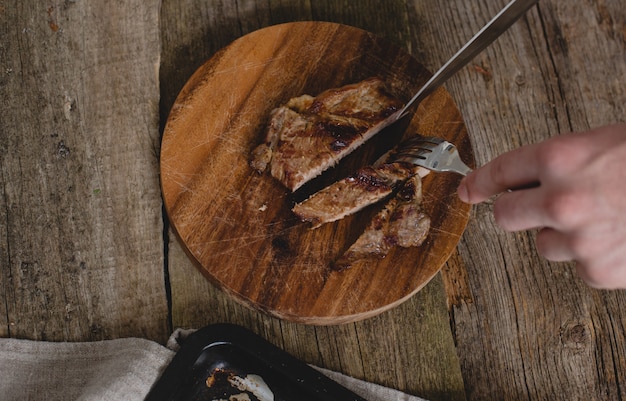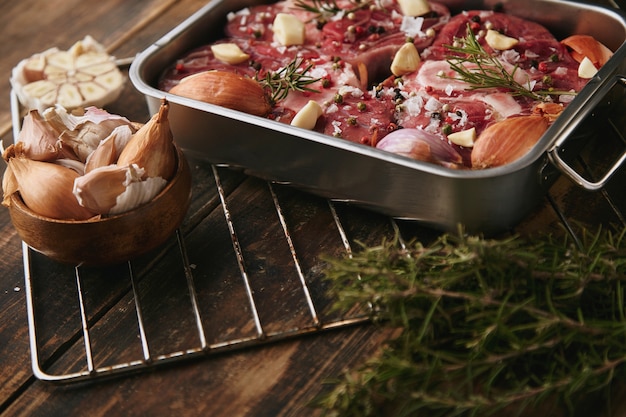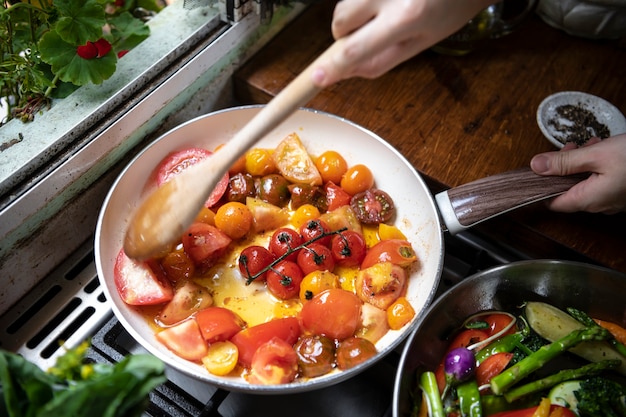For years, I avoided tackling brisket. The intimidating size, lengthy cook times, and the fear of dry, tough meat kept me at bay. But then, I discovered the slow cooker. It was a revelation. No more sweating over a hot stove or fretting about timing. The slow cooker became my culinary confidante, a silent partner in creating the most tender, succulent brisket, effortlessly.
Let me tell you, the slow cooker is a true game-changer for brisket. Imagine this: you throw the ingredients in, set the timer, and forget about it until dinnertime. Then, the aroma of slow-cooked goodness fills your home, beckoning you to the table. You come to find the brisket practically falling apart, its juices running like a delicious river. It’s the kind of brisket that makes you want to lick your plate clean, and then lick it again, just to be sure you didn't miss a single delicious morsel.
Part 1: The Journey Begins: Choosing Your Brisket

My brisket journey started, as all good journeys do, at the butcher's. I confess, I felt a little overwhelmed standing amidst all those cuts of meat. But the butcher, with his warm smile and twinkle in his eye, patiently walked me through the options. He explained the difference between point and flat cuts, helping me choose a brisket that was just the right size for my family. He even offered to trim it for me, removing any excess fat. This is a tip I highly recommend as it ensures even cooking and prevents the brisket from becoming too greasy.
Choosing the Right Brisket: Point vs. Flat
The choice of cut is a crucial first step. There are two main types of brisket:
- Point: This cut, known as the "point," is the fattier part of the brisket. It's full of flavour, but can be a bit tougher if not cooked properly. The fat melts down during cooking, lending a delicious richness to the meat. Think of it as the decadent, buttery side of brisket.
- Flat: The "flat" is leaner than the point, offering a more consistent texture. It's not as juicy as the point, but it's ideal for slicing thinly for sandwiches, creating a lean and satisfying bite.
Many butchers sell a "whole packer" brisket, a combination of both point and flat. This is a great option for larger gatherings, as it offers a delightful mix of textures and flavours. You get the best of both worlds!
Part 2: Prepping Your Brisket: Rubbing It Right

Now, let's prep our brisket for its slow-cooker adventure. This involves a simple rub that infuses the meat with depth of flavour and helps create a beautiful crust. And here's a little secret: pat your brisket dry with paper towels before applying the rub. This ensures that the rub adheres properly and doesn't become clumpy.
The Secret Weapon: The brisket rub
The rub is your chance to get creative! I've experimented with countless combinations, but there's one that’s always a winner:
| Ingredient | Quantity |
|---|---|
| Kosher Salt | 2 tablespoons |
| Black Pepper | 1 tablespoon |
| Garlic Powder | 1 tablespoon |
| Onion Powder | 1 tablespoon |
| Paprika | 1 tablespoon |
| Brown Sugar | 1 tablespoon |
| Chili Powder | 1 teaspoon |
Mix all the ingredients together and rub it generously all over the brisket. Make sure to get it in every nook and cranny. Then, let it sit for at least 30 minutes, or even better, overnight in the refrigerator. This gives the flavours time to penetrate the meat, leading to a truly flavour-packed brisket.
Part 3: The Slow Cooker: Your Culinary Best Friend

Finally, we arrive at the moment of truth – the slow cooker! This is where the magic happens. I recommend using a slow cooker with a capacity of at least 6 quarts for a whole packer brisket. You can always adjust the size based on your brisket's size and how much you're making.
Setting the Stage for Success: Liquid Foundation
Before you introduce your brisket, there's a crucial step: layering the bottom of the slow cooker with liquid. This is essential for keeping the brisket moist and tender throughout the long cooking process. You can use beef broth, water, or a combination of both. Aim for enough liquid to cover the bottom of the slow cooker, but not so much that it completely submerges the brisket. About 1 cup of liquid should do the trick.
Introducing Your Brisket: Fat Side Up
Now, gently place your prepped brisket into the slow cooker, fat side up. This allows the fat to render, adding moisture and flavour to the meat. Don't overcrowd the slow cooker; it might affect the cooking process. Give your brisket some space to breathe and cook evenly.
Part 4: The Slow and Steady Path to Brisket Bliss: Low and slow cooking
With your brisket nestled in its slow cooker haven, it's time to set the stage for its long and delicious journey. The key is to cook the brisket on low heat for a long period of time, allowing the meat to become incredibly tender and succulent. I usually cook my brisket on low for 8-10 hours. But don't worry, you don't have to stand over the slow cooker the entire time. Go about your day and let the slow cooker do its thing. Just keep an eye on it and top up the liquid if needed.
The Art of Patience: Trust the Process
Resist the urge to open the slow cooker and peek at your brisket too often. It's best to let it be and trust the process. This allows the moisture and flavours to penetrate the meat deeply, resulting in the most delicious brisket you've ever tasted.
Part 5: The Moment of Truth: Testing for Tenderness
After 8-10 hours of slow-cooking magic, it's time to check if your brisket is ready. But how do you know? Simple! Use a fork. Gently pierce the brisket. If it easily pulls apart, you're ready to go. If not, give it another hour or two of cooking time. Remember, you can always cook a brisket for longer, but you can't "un-cook" it! So, err on the side of caution and let it cook a little longer than risk it being undercooked.
The Importance of Rest: Let the Juices Redistribute
Once your brisket is cooked to perfection, it's time to let it rest. This is crucial for allowing the juices to redistribute throughout the meat, ensuring it stays moist and tender. I recommend letting it rest for at least 30 minutes, or even longer if you have the time. Cover the brisket with foil while it rests to keep it warm and moist.
Part 6: Slicing and Serving: The Final Act
After its well-deserved rest, the brisket is ready to be sliced and served. This is where you can get creative. You can slice it thin for sandwiches, or thick for a more hearty meal. I love to slice it against the grain, which helps to make it even more tender. But, of course, you can slice it however you like. It's all about personal preference.
Dressing Up Your Brisket: Sides and Sauces
Once sliced, the brisket is ready to be enjoyed. I love to serve it with a simple side of mashed potatoes, coleslaw, and a tangy barbecue sauce. But you can be creative with your sides and choose anything that complements the rich flavour of the brisket. Think about some of your favourite comfort food pairings – cornbread, mac and cheese, or even roasted vegetables. The possibilities are endless!
Part 7: Beyond the Basics: Adding Flavour and Fun
Now that you've mastered the basics, let's explore some ways to add extra flavour and fun to your slow cooker brisket.
Adding Extra Flavour: Taking It Up a Notch
You can add a few extra ingredients to your slow cooker to boost the flavour profile of your brisket. For a smoky kick, try adding a few tablespoons of smoked paprika or chipotle powder to your rub. For a bit of sweetness, add a splash of bourbon or apple cider to the slow cooker. And if you're feeling adventurous, try adding a few cloves of garlic, a handful of fresh herbs, or a few diced onions to the slow cooker. The possibilities are endless!
Beyond the Plate: Using Leftover Brisket: A Culinary Treasure
Leftover brisket is a gift from the culinary gods! It's perfect for sandwiches, tacos, salads, or even just a simple snack. You can shred it and add it to soups and stews, or even use it to make a delicious brisket hash. It’s the gift that keeps on giving, offering endless possibilities for creative culinary adventures.
Part 8: FAQs: Your Questions Answered
What if my brisket is too fatty?
If your brisket is too fatty, you can trim it before cooking. You can also use a meat thermometer to check the internal temperature of the brisket and ensure that it's cooked properly. The brisket is considered safe to eat when it reaches an internal temperature of 145°F (63°C).
What if my brisket is too dry?
If your brisket is too dry, you can add more liquid to the slow cooker during the cooking process. You can also try wrapping the brisket in foil during the last hour of cooking to help it retain moisture. If your brisket is already cooked and is too dry, you can add some sauce to it, or even try shredding it and adding it to a soup or stew.
How long can I keep cooked brisket in the fridge?
Cooked brisket can be stored in the refrigerator for up to 4 days. Make sure to store it in an airtight container. You can also freeze cooked brisket for up to 3 months. To freeze brisket, wrap it tightly in plastic wrap and then in foil. When you're ready to use it, thaw the brisket in the refrigerator overnight.
Can I cook brisket in the oven?
Yes, you can cook brisket in the oven. Preheat the oven to 325°F (160°C). Place the brisket in a roasting pan, fat side up, and cook for 4-5 hours, or until the internal temperature reaches 145°F (63°C). You can add a cup of liquid to the bottom of the roasting pan to keep the brisket moist.
Can I use a different type of meat in my slow cooker?
Yes, you can use other types of meat in your slow cooker, such as pork shoulder, chicken, or beef chuck roast. These cuts of meat are also great for slow cooking and will become incredibly tender and juicy. Just adjust the cooking time accordingly, and don't forget to add some liquid to keep the meat moist.
So, there you have it, my dear friends. A slow cooker brisket adventure that’s sure to change the way you think about this delicious and versatile cut of meat. It’s not just about the recipe, it’s about the experience. The anticipation, the aroma that fills your kitchen, the joy of sharing a meal that’s been lovingly prepared. It’s a journey worth taking, and one that will leave you craving more, and more, and more!
Everyone is watching

How to Cook Frozen Lobster Tails Perfectly: A Step-by-Step Guide
RecipesLobster. Just the word conjures up images of lavish meals, special occasions, and a taste of luxury. But let's...

Pork Fillet Cooking Time: How Long to Cook It Perfectly
RecipesPork fillet, or tenderloin as it's sometimes called, is a real favourite in our house. It's so versatile, and...

Pigs in a Blanket Cooking Time: How Long to Bake for Perfect Results
RecipesAh, pigs in a blanket. Just the name conjures up images of those delightful little parcels of crispy pastry en...

The Ultimate Guide to Cooking Delicious Frankfurters
RecipesLet's face it, we all love a good frankfurter. It's a classic, simple, and always satisfying. But let's be rea...

Wolf Meat Recipes: A Guide to Cooking Wild Game
RecipesLet's be honest, you don't see wolf meat at your local butcher shop every day. It's a bit of a wild card, but ...
